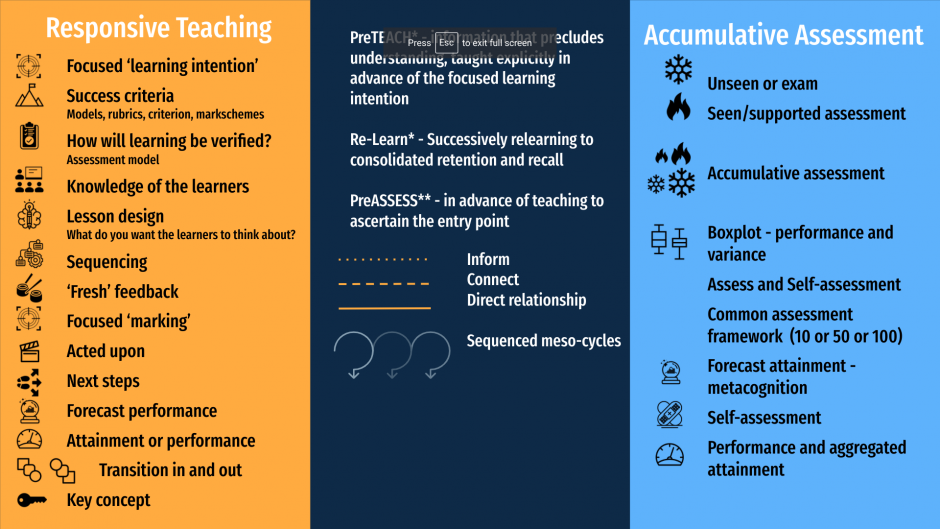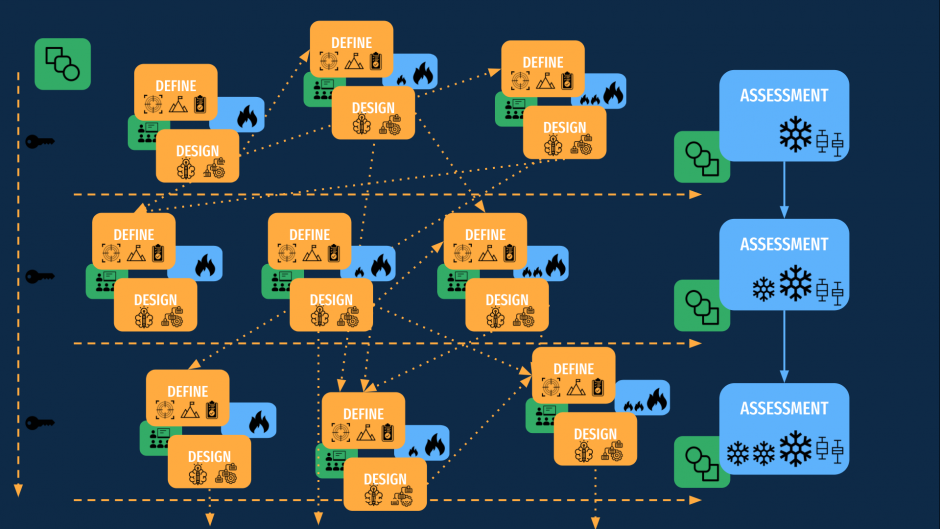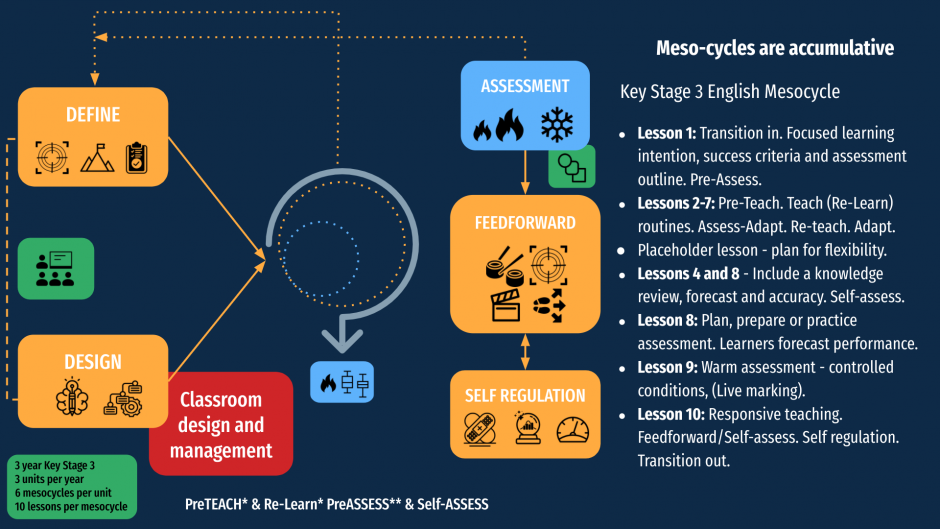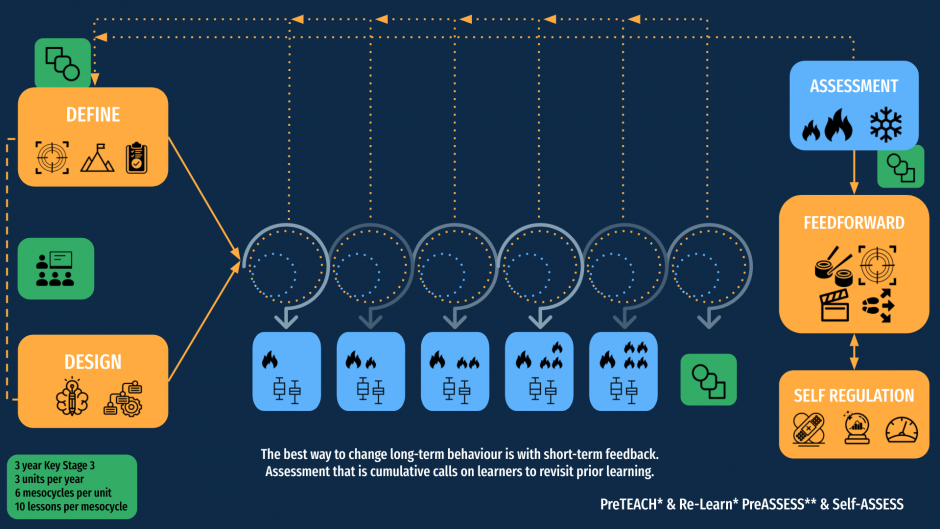Having drafted a five part series on curriculum planning and designing a flexible Teaching-Instruction Model (that accommodates my professional interest in Complex Adaptive Systems), I was asked if I could go through the steps I would take when designing a scheme of work, and also delivering / refining / adapting a scheme of work, as a connected, coherent sequence of meso-cycles, and cumulative assessments as a class teacher.
Converting the model to a proforma is easier said than done, as in organising the ideas behind the model, I learnt the following:
- An independent scheme of work – sits within a connected, coherent and cumulative curriculum
- The design steps I proposed are not linear and may be fined and/or adapt as a result of teaching
- A model works with wider school practice and policy eg assessment, marking, homework and behaviour policies.
- The best starting point is the “end.” Not such an easy proposition if you have not experienced many “end points” before
- The model relies heavily on Successive Relearning, Responsive Teaching (acculumative assessment) and routines
- The process openly accepts that classrooms, teaching and instruction, and assessment are complex, far beyond any model
- The model only plans 80% of the curriculum time – to allow teacher to respond to teaching and learning, for revisiting and securing knowledge
Below are the five posts that shared the development and organisation of the ideas behind the Teaching-Instruction Model.
Teaching-Instruction Model in Action
Below are four of the seven slides upon which the proforma is based on. The first two broad sets of decisions will have already been made for the class teacher.
In addition to various policies, teaching also accommodates various events and dates influencing classroom teaching (Parents Evenings, Options Evenings, data collection) are set a the school level, possibly interpreted at the department level.
I would expect most Heads of Department to have met with senior colleagues, and as the experts, knowing the school and the context, set the exam board, organised and sequenced the curriculum, the key concepts and links. At the very least, ‘Defined’ and ‘Designed’ the macro cycles, including the macro assessment, success criteria and markschemes. If not – you need these to build effect schemes of learning.
If not yet built, this could be an excellent departmental activity and conversation (if a little later than desired). I tend to work offline with pen and paper first, present a model, an initial rational and invite critique. Allowing time for these ideas to iterate, percolate, is often worthwhile. Working collaboratively (or not), defining and organising the declarative knowledge, presents an opportunity to use RememberMore, building the categories and tags, often surfacing inherent connections and links.
I would also expect, that any teacher expected to build a scheme of learning, would have access to the Curriculum Plan and their class lists, student prior attainment and key characteristics – he says striking the Ausubel (1968) drum and you will see from the Twitter poll I may have over anticipated school preparedness.

I will let you decide which teachers are more likely to launch with confidence.
Teaching-instruction Model Slides
Slide 1 provides the terms of reference. Slides 2-4 illustrate the process.
Slide 2
- Step one: Know the learners – create a class profile. What is to be taught – the focused learning intention, success criteria and assessment.
- Step two: Scope the macro (accumulative) assessment(s)
- Step three: With the macro cycle in hand, sequence the meso-cycles (making the links and connections explicit) and know how you plan to assess students learning
Slide 3
- Step four: Is there any declarative knowledge, eg specific vocabulary, worthy of pre-teaching? Design each meso-cycle (Successive Relearning and Responsive Teaching) knowing that teaching and assessment will inform the live plan. This is a live document per class.
- Knowing what declarative knowledge you want the learners to retain – plan the thinking you want the students to undertake. Plan the assessment. Plan lessons 2-8. Plan time to re-teach or practice.
Slide 4
- Step five: Review the meso-cycle sequence and completed macro cycle and assessment.
- Does the assessment, assess what it is you intend the students to learn? How will you know?
Teach-Assess-Adapt.
- Step six: As inherent within the teaching-instruction model, every micro-cycle or lesson is swamp of teach-assess-adapt decisions. So teaching and of course assessment provides evidence and insights. After each meso-cycle, use this evidence and experience to amend the now historic plan, and with foresight, adapt the future meso-cycle.
- Step seven: Review the assessment as feedback on your teaching and on students learning. Assess the assessment difficulty, learner attainment and performance variance? A common mistake is often a teaching error? Reteach. Sporadic errors are more likely to be owned by learners. Make the feedback/feedforward detective work for learners. Advise learners to be cautious of individual meso-assessment performance. Aggregated scores will always be more reliable. (Is the last three score mean, improving on their mean score).
- Step eight: At the end of the macro cycle, revise the plan based on the evidence you have collected.
- Optional: Asking students for their feedback can be insightful.
Planning a sequence of mesocycles
Keep in mind the macro-cycle plan. Know that planning a sequence of mesocycles (a macrocycle) is not a sequential process. Plan time to adapt and reteach. Successive Relearning and Responsive Teaching are central teaching-instruction tenets within a mesocycle, and accumulative assessment over the macrocycle.
Planning a sequence of mesocycles
| Model | Step 1 | Notes |
| Know the learnersKnow their context and needs | Create a class profile. ClassCharts / MIS export.Student name / preferred names. Print the student photo. Gender. SEND (colour code?) Standardised scores (eg reading age). Prior attainment. Seating Plan. | |
| Insight | Previous attainment? Can you speak with the previous teacher? Intel? | |
| Preparation Beyond the model | Prepare your markbook. Can you share good new, success – early. What is the routine for entrance, starts and exits? Walk the entrance and exit routines. Are the school ‘Values’ visible? “Our school Values” depersonalises classroom management. Your proximity is a powerful tool. Get out into the classroom. |
| Define – Has the Macro-cycle been defined? | Step 1 | Notes |
| What is your curriculum allocation? Has the Macro cycle been defined? How many Macro cycles? Made up of how many meso-cycles? How do these mesocycle overlay the academic calendar? Made up of 8-12 lessons? How are the lessons distributed? | Periods per week? Yes/No? Half-termly? Termly? Annually? Over one week? Two weeks? | |
| Core | 36*5 = 180 periods (5*60mins per wk) 6 Mesocycles (10 lessons every 2 wks) per Macro cycles (3)18 Assessments | |
| Foundation | 36*2 = 72 periods (2*60mins per wk) 3 Mesocycles of (12 lessons every 6 wks) per Macro cycles (2)6 Assessments | |
| Check the school calendar. Plan for expected interruptions. Plan time to adapt and reteach or practice. Plan for unexpected interruptions | The summer term is often interrupted by annualised exams and whole school events. | |
| What is to be taught? | Focused learning intention, success criteria and assessment. | |
| Design | Step 4 | |
| What are the Focused ‘learning intentions’? Define the declarative knowledge? Is there any declarative knowledge, eg specific vocabulary, worthy of pre-teaching? Plan the assessment. Plan lessons 2-8. Plan time to re-teach or practice. | How are these to be distributed? Ordered? This knowledge can be added to RememberMore. Knowing what declarative knowledge you want the learners to retain – plan the thinking you want the students to undertake. What is not to be taught? What distractions may you incur? | |
| Has the Success criteria been defined? | Models, rubrics, criterion, markschemes? Model answers? When and how are grades reported? Will you have assessment insights available to respond? | |
| Macro: How will learning be verified? | See Assessment | |
| Meso: How will learning be verified? | See Assessment |
| Assessment | Step 2, 3 and 5 | Notes |
| Accumulative | Each mesocycle assessment is accumulative – drawing on the knowledge gained from previous meso-cycles. Does the assessment, assess what it is you intend the students to learn? | |
| Responsive Teaching Feedforward Self-regulation | Each assessment presents an opportunity for the teacher / students to respond to what was learnt and what was not yet retained. Responsive Teaching gives learners the opportunity to reflect, take ownership of learning and act upon feedback. | |
| Common Assessment Framework | Where possible, assess to a common framework.Score out of 10? Or 100? Adjust all assessment= Check the school assessment framework.For example, a score out of 10 | |
| Macro: How will learning be verified? Do you know what it takes to be successful on your assessment? What is the whole school assessment policy? | Scope what your macro-cycle assessments will look like, under controlled classroom conditions. How will these x macrocycle assessments support an annual or terminal assessment? Cold assessments are designed to verify attainment.In Core subjects, you may record 3-6 Macro assessments, plus an annual assessment. | |
| Meso: How will learning be verified? | Scope what your meso-cycle assessments will look like under classroom conditions. What knowledge are the students showcasing and developing or practicing? How will these x mesocycle assessments support the macro assessment? Warm assessment – controlled conditions. (Applied practice, for learning, in class, live marking is an option) |
The next phase of the Teaching-Instruction Model is Teach-Assess-Adapt. With regards to planning, this is an iterative, live and ongoing process, unique to each class, often with commonalities across classes.
Using mesocycles as milestones, monitor and aggregate learner performance and attainment. I often write directly onto an offline plan, observations, adaptations, improvements for the next iteration and use feedforward lessons to target unfilled learning intentions.
| Teach-Assess-Adapt | Step 6, 7 and 8 | Notes |
| After each meso-cycle update the plan, in hindsight, and foresight. | Teach-Assess-Adap Use this evidence to amend the now historic plan, and with foresight, adapt the future meso-cycle. | |
| Use assessment as feedback on your teaching and on students learning. | Assessment as evidence | |
| After each macro cycle update the plan, in hindsight, and foresight. | Teach-Assess-Adapt At the end of the macro cycle, revise the plan based on the evidence you have collected. |
I do hope this help, especially those teachers expected to refine that schemes in light of collecting their class lists at INSET.






